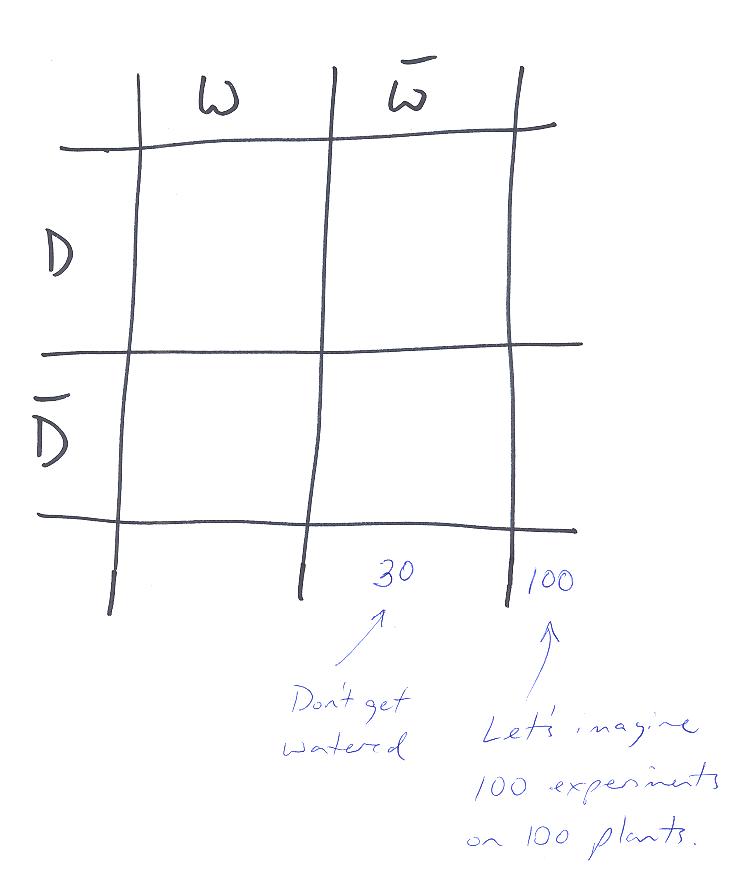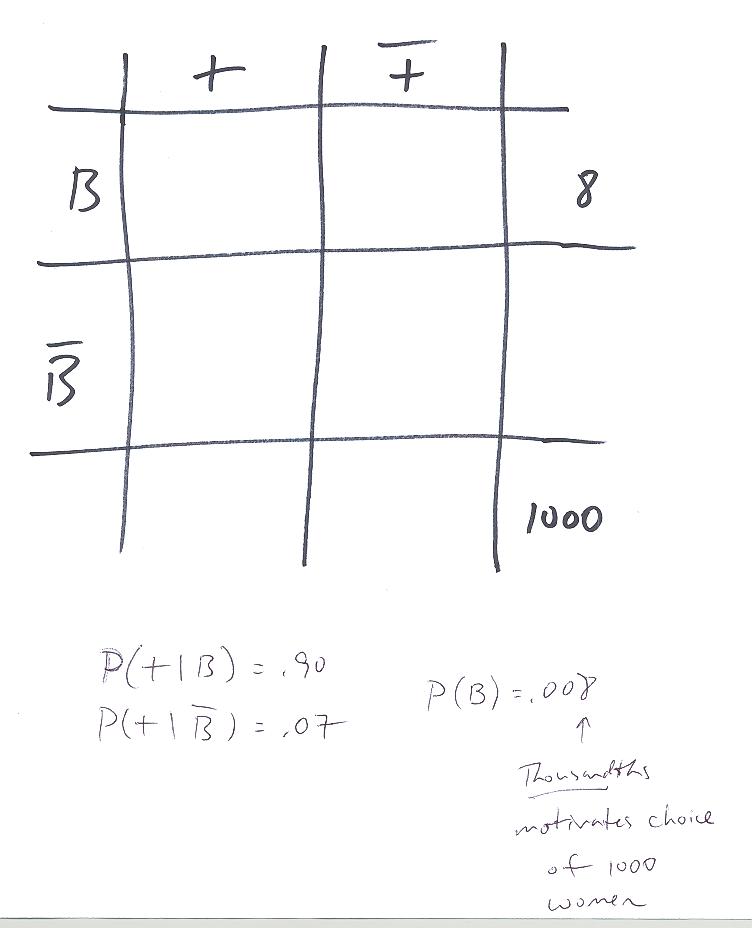- Remember: you have an assignment due Friday.
- You also have a new reading assignment for Friday: Location, Location, Location (p. 35)
Question of the Day: What happens when you're falsely accused of doping at work?
Recall that our reading emphasizes is how bad "the experts" really are at probabilities. We rely on them, but maybe we shouldn't when it comes to risk. Let's see if we can do better than the experts!
We started with some vocabulary:
- conditional probability -- probability that an event happens given that some other thing has already happened
- "intersection" and Venn Diagram
- Bayes's Theorem
Last time we worked out "the plant problem":
- Before going on vacation for a week, you ask your spacy friend to
water your ailing plant. Without water, the plant has a 90 percent
chance of dying. Even with proper watering, it has a 20 percent chance
of dying. And the probability that your friend will forget to water it
is 30 percent.
- What's the chance that your plant will survive the week?
- If it's dead when you return, what's the chance that your friend forgot to water it?
- If your friend forgot to water it, what's the chance that it'll be dead when you return?
- We usually start by defining some things. For example we could let
-
- the plant died
-
- the plant was watered
then, of course, we have also defined the complements:
-
- the plant didn't die
-
- the plant was not watered
-
- We used a Venn diagram to construct the universe.
- Next we introduced the notion of conditional
probabilities: for example,
The robability of
given
is written as
Here's "Bayes's Theorem", which relates the conditional probabilities to the probability that both of two different things happen in a set:
And because the order of the intersection (both happening) doesn't matter, the problem is symmetric in D and W:
These are useful, provided we know two of the three quantities -- then we can solve for the third.
And since the two quantities on the left-hand sides are equal, we can equate the right-hand sides:
This is Bayes's Theorem (and is especially useful provided we know three of the four quantities -- then we can solve for the fourth).
The given probabilities are
-
- We can now turn the English questions posed at the beginning of
the plant experiment into the following probabilities:
- What's the chance that your plant will survive the week?
- If it's dead when you return, what's the chance that your
friend forgot to water it?
- If your friend forgot to water it, what's the
chance that it'll be dead when you return?

With that table we've answered the first of the three questions:
- The probabilitiy that your plant will survive the week (is not dead) is
- The probabilitiy that your plant will survive the week (is not dead) is
- If it's dead when you return, then the chance that your
friend forgot to water it is
- If your friend forgot to water it, what's the
chance that it'll be dead when you return?
- What's the chance that your plant will survive the week?
- Now our author suggests that, rather than go through all this
convoluted stuff, we think in terms of "natural frequencies". Let's
see if we get the same answer any easier. Let's assume that there are
100 plants in the experiment, all either dead or not-dead, watered or
not-watered.
Once again, we'll use a Table. The trick to natural frequencies is to consider a large number of individual plants, and turn probabilities into numbers. Since the probability of not watering is .30 (30%), we might think "30 out of 100" wouldn't be watered. And that might suggest that we consider 100 plants:

Now we fill in the rest of the table, using the info provided:
-
"Gigerenzer and his colleagues asked doctors in Germany and the United States to estimate the probability that a woman with a positive mammogram actually has breast cancer, even though she's in a low-risk group: 40 to 50 years old, with no symptoms or family history of breast cancer.
"The probability that one of these women has breast cancer is 0.8 percent. If a woman has breast cancer, the probability is 90 percent that she will have a positive mammogram. If a woman does not have breast cancer, the probability is 7 percent that she will still have a positive mammogram. Imagine a woman who has a positive mammogram.
"What is the probability that she actually has breast cancer?"
We'll use "natural frequencies" to solve this problem. We begin by establishing the variables:
-
- has Breast cancer
-
- tests Positive
then, of course, we have also defined the complements:
-
- doesn't have Breast Cancer
-
- tests Not Positive
- Let's turn the question into a conditional probablility:
"What is the probability that she actually has breast cancer, given that she tested positive?" translates into
- To answer that question, let's start by considering the
universe. The best way to represent it is as a "natural
frequency" table.
Here's what we know (turning the givens into probabilities):

Starting with 1000 women, let's fill in the rest of the table.
Notice that our author estimates -- rounds -- answers, to make his life a little easier. You might check that our answers round off to his answers. Often the approximations are sufficiently good.
-
- There are two entries of four in the table that we'd like to
eliminate entirely: so-called "false positives" and "false
negatives". Each has its problems. Characterize each type of
problem in the breast cancer example.
Characterize each type of error in terms of drug testing.
- Now that we've calculated the exact values, what do you think of
this quote from our text:
"As for the American doctors, ninety-five out of a hundred estimated the woman's probability of having breast cancer to be somewhere around 75 percent."
What are the consequences for your health care?
- Notice the difference between the German doctors and the American
doctors:
- 33% (8 of 24) German doctors estimated less than 10% (close! -- 9%)
- 95% of American doctors estimated around 75% (far! -- 9%)